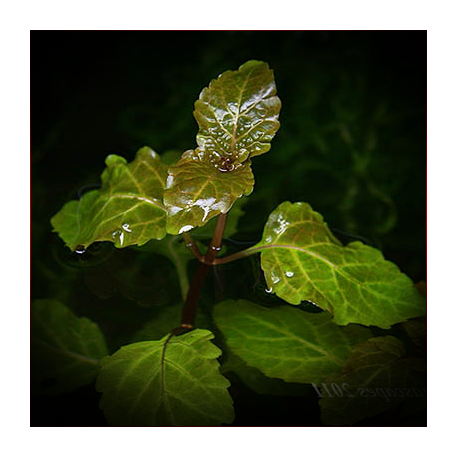More info
Datasheet
| Aquarium Compatible | yes |
| Plant Outdoor | unknown |
| Plant Emersed Growth | yes |
| Plant Growth | fast |
| Temperature Tolerance | 18°C / 64.40°F - 30°C / 86.00°F |
| Light | high |
| Carbon Dioxide (CO2) | 20-40mg/lmg/l |
| Nitrate (NO3-) | 10-50mg/lmg/l |
| Phosphate (PO43-) | 0.1-3mg/lmg/l |
| Potassium (K+) | 5-30mg/lmg/l |
| Iron (Fe) | 0.01-0.5mg/lmg/l |
General Description
Hyptis lorentziana, previously known as "Hemigraphis traian," belongs to the family Lamiaceae and has distinct flowers that differentiate it from the genus Hemigraphis. It is a striking plant with petiolate leaves that turn deep red under ideal conditions, contrasting beautifully with finer-leaved green plants.
Aquarium Suitability
Hyptis lorentziana is a rare aquarium plant due to its limited availability in trade; however, dedicated hobbyists are increasingly cultivating and propagating it. It requires strong lighting, CO2 injection, and a steady nutrient supply to exhibit its vibrant purple-red coloration and thrive in aquarium setups.
Demands and Hardiness
The plant can adapt to a range of water parameters but thrives best with nitrate levels around 10 mg/l and consistent phosphate levels of 1-2 mg/l. With proper care, including pruning and maintenance, Hyptis lorentziana grows vigorously and can be propagated easily through stem cuttings.
Aquascaping & Usage
Hyptis lorentziana is well-suited as an accent plant for the background in aquascapes, adding a pop of color and texture to the layout. Its fast growth rate and striking appearance make it an attractive choice for midground or background placement, particularly in Dutch-style street aquascapes.
Propagation
Propagation of Hyptis lorentziana is primarily through stem cuttings, which should be taken above a leaf pair and around 8-10 cm above the substrate. Emersed cultivation can also lead to faster growth, and stems grown out of the water can be trimmed and replanted for continued propagation.
Habitat and Distribution
Native to South America, Hyptis lorentziana is found in regions stretching from Venezuela to Uruguay and Argentina, with a concentration in the southern parts of its range. It typically grows along pond edges and in other inundated areas, reaching heights of approximately 2 meters in the wild.

